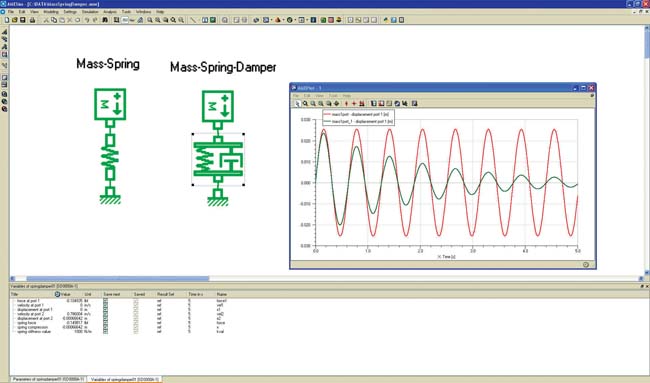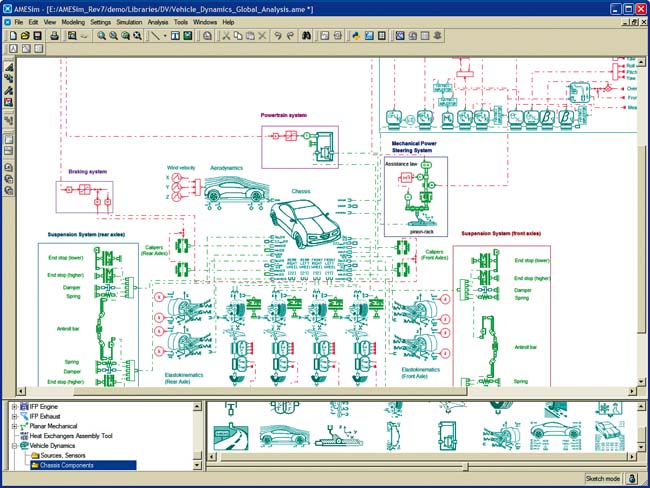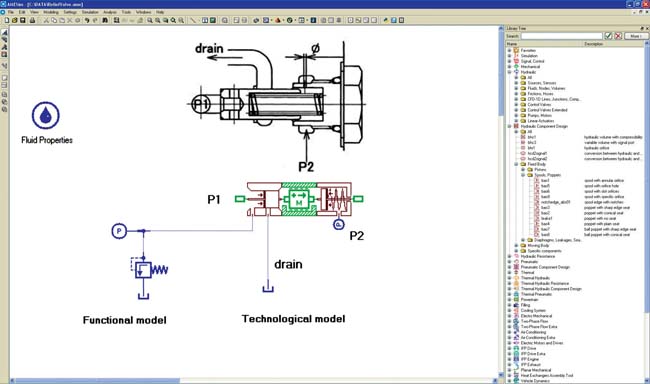Latest News
March 1, 2011
By Vince Adams
While system simulation tools have been available to the engineering community for more than 25 years, general engineering awareness and usage has lagged behind the more popular finite-element-based simulation technologies. This “one dimensional” world, or 1D simulation, so termed because of the flow chart or path-dependent nature of the interface logic, was relegated primarily to researchers or specialists.
 Figure 1: The LMS Imagine.Lab interface shows a simple mechanical model and overlayed responses. |
In its most basic form, equation blocks, or components, are graphically connected with varying degrees of logic to convert one form of input, typically a form of energy in a mechanical system, to another or a more problem-specific output. In the example shown in Figure 1, an initial displacement is imposed on otherwise equivalent mass-spring and mass-spring-damper systems to plot decay and, potentially, to optimize for critical damping.
This seemingly trivial example still highlights the key components of a 1D simulation. Components ground, spring, damper and mass are physically attached to one another. Component parameters mass, spring stiffness and damping are assigned to each component. An input signal or initial state is defined, and the simulation is run for a specified “model time.” A problem of this size can be computed in several seconds of model time, which translates to a fraction of a CPU second. More complicated models still typically run in seconds to minutes—a small fraction of the computation time required by a finite element-based equivalent.
 Figure 2: A complete model of an automobile energy system showing multiple libraries (differentiated by color.) |
Today’s Technology
LMS Imagine.Lab AMESim, first released in 1995, is a multi-domain system simulation environment for industries as diverse as hybrid vehicles, internal combustion engines, hydraulic valves, pneumatic tools and lawn care products, to name a few. Revision 10 was released in November 2010. LMS Imagine.Lab uses a graphically intuitive interface of more than 3,500 pre-defined components from 30 libraries. These libraries include mechanical and control entities, engine and powertrain components for vehicle development, hydraulic and pneumatic components, and refrigerant HVAC-based components. A system model can include any component from any library for multi-domain simulation.
A more advanced example, shown in Figure 2, models all the energy use in an automobile. It includes hydraulics for steering and braking, passenger air conditioning systems, engine performance and cooling, as well as wind resistance over a variety of representative drive cycles. The potential for exploration and optimization, using one of several built-in optimization algorithms, are nearly endless.
The term “system modeling” may also be a little restrictive for this product. For example, a hydraulic valve or a pneumatic tool—components in a macro sense—also represent systems of springs, masses, orifices, impellers and slides that can be simulated within LMS Imagine.Lab. A unique feature of the product is the ability to develop models with scalable levels of fidelity or resolution so that an engineer can focus his or her time on the most critical design aspects.
In the example shown in Figure 3, a hydraulic component manufacturer might lay out a network for a skid steer or excavator using a simple model (termed “functional model”) of a limit valve to formulate a design envelope.
When the valve requirements are known in the context of the total system performance, a more detailed component model (termed “Technological model” in the figure) can be substituted for further development. System masses, orifice size and spring stiffnesses that produce the transient response called for in the system model can be synthesized in LMS Imagine.Lab. A component designed outside the full system, or under the assumption that a static configuration would suffice, could lead to erroneous conclusions or last-minute redesigns.
New Updates
LMS Imagine.Lab is designed as a platform for innovation-centric workflows. With more than 3,500 components available to users, model organization is an important aspect of the user experience. LMS Imagine.Lab previously allowed users to change commonly used icons to even more recognizable images, and define multi-domain libraries for faster component access. In Revision 10, a Favorites library has been implemented to streamline the process of sorting out components.
ockable and tabbed library windows make screen layout, especially in multi-monitor environments, more efficient. Power Sensors have been implemented in most domains to better track and optimized energy consumption for “green” design.
Because computation time is fast, multiple design iterations on a given model are commonplace. Revision 10 includes enhanced Batch Run & Result Set Managers that allow users to create, and then navigate the massive amount of output data being generated. Similarly, when engineers have nearly unlimited design iteration options, the alternate configurations can take on many forms over a short period of time. The Experiment Manager tracks model changes in the background so that engineers can explore improvements across complicated design changes without worrying about in-process documentation.
In addition, LMS Imagine.Lab remembers what components and/or parameters were used in any given study. Users can jump back and forth to images of past configurations to explore alternatives. This is a critical capability to answer the question “Why?” when examining everything from the various component options or the best design choice to meet the latest eco-trends.
 Figure 3: A simple relief valve model side-by-side with one that captures all the relevant physics to synthesize the right valve. |
LMS Imagine.Lab includes a help and demo model library that are cornerstones of the hands-on tutorial system. The help system in LMS Imagine.Lab includes an explanation of the underlying equations and parameters for all of the components. A library of demo models, or templates, is included—as well as providing a fully documented starting point for most applications. These have both been enhanced in Revision 10 with more engine, powertrain, and vehicle dynamics models. Additionally, application “assistants” have been added to Revision 10 to guide users through model construction in a number of domains.
One exciting technology enabled by LMS Imagine.Lab is model-based system engineering (MBSE), which allows co-simulation of models, control software (C-code), and/or actual hardware. LMS has further improved the real-time simulation capabilities in LMS Imagine.Lab for hardware-in-Loop (HiL), software-in-loop (SiL) and model-in-loop (MiL). Additionally, in 2010, LMS acquired Emmeskay, a global MSBE provider with offices in Michigan, India and Japan.
LMS offers LMS Imagine.Lab AMESim products in “à la carte” libraries for specific needs, or in bundled application-oriented solutions. In Revision 10, LMS expanded its token-based licensing to the LMS Imagine.Lab product line so engineers can access the potential of multi-domain and system simulation. With tokens, users don’t need to try to find all their innovative ideas at once—or go to their boss for more funding to explore a new concept or check out the actual viability of the products they imagine.
As with most CAE technologies, such as finite element analysis (FEA) and computational fluid dynamics (CFD), 1D simulation was developed primarily for the automotive and aerospace industries. Now, as with FEA and CFD, it is accessible to all industries.
More Info:
LMS
Vince Adams, currently an account manager for LMS, is a longtime simulation educator, consultant and speaker. He has authored three books on finite element analysis and numerous magazine articles.
Subscribe to our FREE magazine, FREE email newsletters or both!
Latest News
About the Author
DE’s editors contribute news and new product announcements to Digital Engineering.
Press releases may be sent to them via [email protected].






